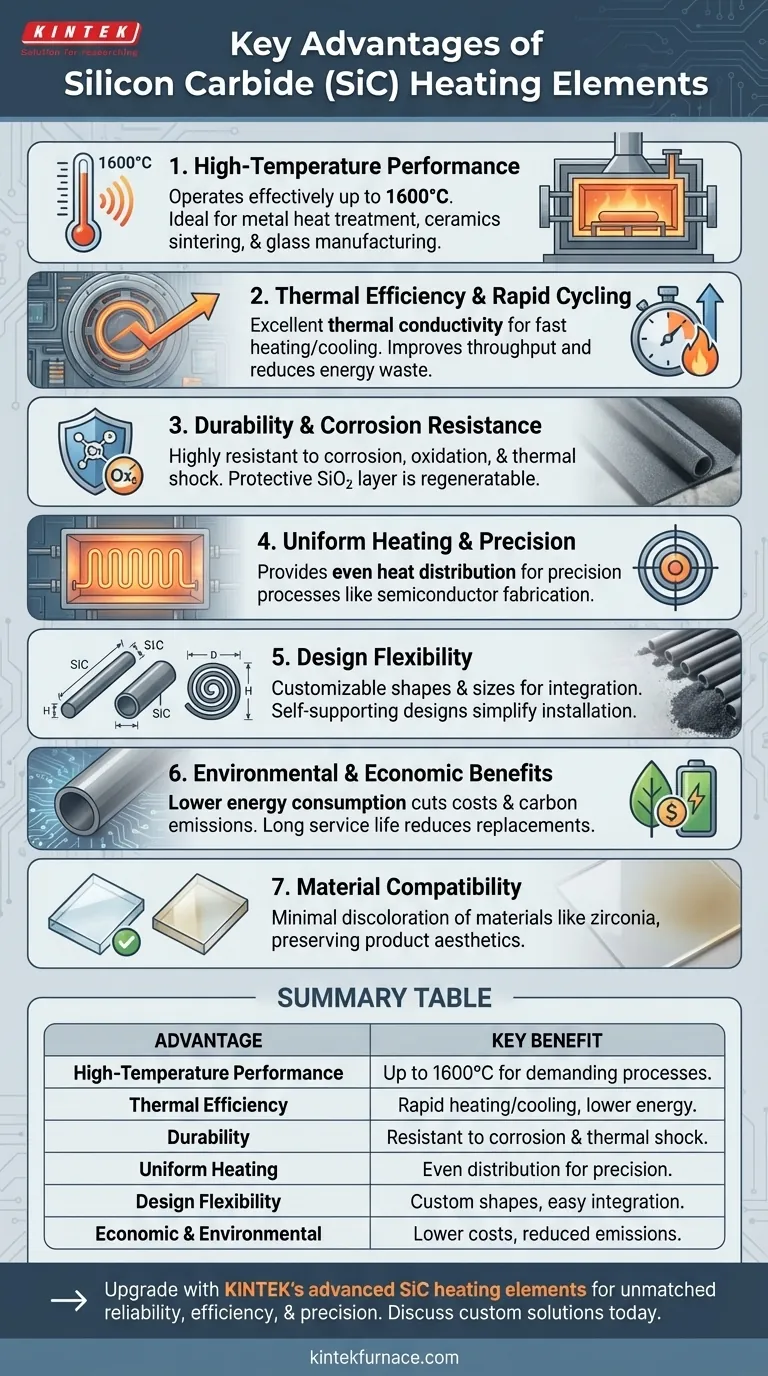Silicon carbide (SiC) heating elements are widely favored in industrial applications due to their exceptional thermal properties, durability, and efficiency. They can withstand extreme temperatures up to 1600°C, offer high thermal conductivity for rapid heating and cooling, and provide uniform heat distribution, making them ideal for precision processes. Their self-supporting nature reduces the need for additional structural support, while their corrosion resistance ensures longevity even in harsh environments. Additionally, SiC elements are energy-efficient, lowering operational costs and carbon footprints, and can be customized in shape and size to fit diverse furnace designs, including controlled atmosphere furnaces.
Key Points Explained:
-
High-Temperature Performance
- SiC heating elements operate effectively at temperatures up to 1600°C, making them suitable for demanding industrial processes like metal heat treatment, ceramics sintering, and glass manufacturing.
- Their stability at extreme temperatures reduces the risk of deformation or failure, ensuring consistent performance over time.
-
Thermal Efficiency & Rapid Cycling
- Excellent thermal conductivity (14–18 kcal/M hr°C at 600°C) enables fast heating and cooling, improving throughput and reducing cycle times.
- This efficiency minimizes energy waste, aligning with sustainable practices and cost-saving goals.
-
Durability & Corrosion Resistance
- SiC is highly resistant to chemical corrosion, oxidation, and thermal shock, extending the lifespan of heating elements even in aggressive atmospheres.
- If the protective SiO₂ layer degrades, it can be regenerated by firing at 1450°C+ in an oxidizing atmosphere, restoring functionality.
-
Uniform Heating & Precision
- Ideal for laboratory and industrial furnaces, SiC elements provide even heat distribution, critical for processes like semiconductor fabrication or precision ceramics.
- Their reliability supports applications requiring strict temperature control, such as in controlled atmosphere furnaces.
-
Design Flexibility
- Customizable shapes (rods, tubes, spirals) and sizes allow integration into compact or specialized equipment, optimizing space and thermal output.
- Self-supporting designs eliminate the need for additional fixtures, simplifying installation.
-
Environmental & Economic Benefits
- Lower energy consumption reduces operational costs and carbon emissions, supporting greener manufacturing.
- Long service life decreases replacement frequency, further cutting costs and downtime.
-
Material Compatibility
- Unlike MoSi₂ heaters, SiC causes minimal discoloration of zirconia, preserving product aesthetics in high-value applications like dental ceramics or jewelry.
By combining these advantages, SiC heating elements address the core needs of industrial buyers: reliability, efficiency, and adaptability. Whether for high-temperature metallurgy or precision lab work, they offer a robust solution that balances performance with sustainability.
Summary Table:
| Advantage | Key Benefit |
|---|---|
| High-Temperature Performance | Operates up to 1600°C, ideal for metal heat treatment and ceramics sintering. |
| Thermal Efficiency | Rapid heating/cooling (14–18 kcal/M hr°C at 600°C), reducing energy waste. |
| Durability | Resists corrosion, oxidation, and thermal shock; SiO₂ layer regeneratable. |
| Uniform Heating | Even heat distribution for precision processes like semiconductor fabrication. |
| Design Flexibility | Customizable shapes (rods, tubes) and self-supporting for easy integration. |
| Economic & Environmental | Lowers energy costs, carbon emissions, and replacement frequency. |
Upgrade your industrial furnace with KINTEK's advanced SiC heating elements for unmatched durability, efficiency, and precision. Our in-house R&D and manufacturing ensure tailored solutions for your high-temperature needs, from metallurgy to lab-grade ceramics. Contact us today to discuss custom configurations or explore our range of controlled atmosphere furnaces.
Products You Might Be Looking For:
Shop high-performance SiC heating elements for electric furnaces Explore vacuum-compatible observation windows for process monitoring Discover precision vacuum valves for system control
Visual Guide

Related Products
- Silicon Carbide SiC Thermal Heating Elements for Electric Furnace
- Laboratory Muffle Oven Furnace with Bottom Lifting
- Vacuum Heat Treat Furnace with Ceramic Fiber Liner
- High Temperature Muffle Oven Furnace for Laboratory Debinding and Pre Sintering
- Split Multi Heating Zone Rotary Tube Furnace Rotating Tube Furnace
People Also Ask
- What is silicon carbide used for in heating applications? Discover Its High-Temperature Durability
- What parameters does the IEC standard specify for heating elements? Ensure Safety and Performance
- What heating elements are used in high-temperature tube furnaces? Discover SiC and MoSi2 for Extreme Heat
- What is the operating temperature of SiC? Unlock Reliable Performance Up to 1600°C
- What is the temperature range for silicon carbide heating elements? Unlock High-Temp Performance from 600°C to 1625°C



















